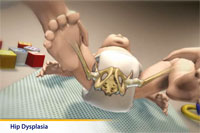
Developmental Dysplasia of the Hip
What is developmental dysplasia of the hip?
When a baby's hip is dislocated or is loose and at risk for becoming dislocated, the condition is called a developmental dysplasia of the hip (DDH). A hip dislocation occurs when the ball of the hip joint slips out of the socket. The ball of the hip joint is the top of the thigh bone and fits in the hip socket to form the hip joint. A baby can be born with a completely dislocated hip or the ball of the hip may fit loosely in the socket. It happens more often in girls than boys and more often in babies born breech. This problem also tends to run in families. If not treated, it can lead to pain and osteoarthritis in early adulthood.
What is the cause?
Ligaments are strong bands of tissue that connect bones at the joint. The thigh bone may not fit securely in the hip socket because the ligaments of the hip joint may be loose or stretched. As a consequence, the depth of the hip socket does not develop normally. It tends to run in families and is seen more often in first-born babies. It could happen in one or both hips. Due to the way most fetuses are positioned inside the mother's uterus, the left hip is affected 3 times more often than the right hip.
How is it diagnosed?
When a baby is born, a healthcare provider will check the baby's hips. If a clicking sound is heard, or the provider thinks there is a problem, the baby is checked again in 2 weeks. The clicking sound usually goes away in 2 to 4 weeks. Many times this problem does not show up at birth. It may develop as the baby gets older. This is why the healthcare provider always examines the baby's legs and hips during a well child visit.
During an exam, the thigh bones will be pushed and pulled to see if they are loose in the socket. As the baby gets older, the provider will see if the baby's thighs spread apart easily. The provider will look to see if one leg is longer than the other.
If your child's provider thinks there may be a problem, an ultrasound or an X-ray may be done. Your child's provider may recommend that you see a bone specialist called an orthopedist.
If your child starts to walk with a limp, toe walks, or waddles with a duck-like walk, he or she needs to be checked to see if there is a hip problem.
What is the treatment?
Treatment is typically easier and safer in a newborn with a dislocated hip than in an older child. It is often treated with a soft brace for 2 to 3 months. The brace is worn day and night. It keeps the baby's knees spread apart and bent toward the chest while holding the hips in the right place. It may help tighten the ligaments and cause the hip joint to form normally. Babies who are 1 to 6 months old are also treated by wearing a harness device to keep the hip in place.
If the harness does not work, a doctor will move the hip back into position. This procedure is usually done under anesthesia so the baby will not feel any pain. The baby is then put in a special body cast to hold the hip in place. Children 6 months to 2 years old are usually treated using this procedure. If the child is over 2 years old and has never been treated for the problem, the deformity may be severe. In these cases, major surgery may be needed.
Your provider will tell you if you can take the harness off. Your provider will probably tell you not to give your baby a bath. Instead, you can use a sponge and cloth to wash your baby. Use soap and a washcloth to clean the harness if it becomes soiled. If you are allowed to take the harness off, it can be washed in the washing machine on a gentle cycle. Let the harness air dry. It is important to have the harness placed with just the right amount of tightness. Both too tight and too loose can lead to problems.
Your baby will be limited in the movement of the lower part of the body while in a harness or body cast. He or she will catch up on all movements after the DDH is successfully treated. Your baby should be able to breast-feed while in the harness or body cast. Treatment for DDH usually lasts 6 weeks or longer.
Your provider will determine how long your baby needs to wear the harness or body cast. Your provider will look at X-rays or ultrasounds to check if it is time to remove the harness or cast. If a hip dislocation is found and treated early, children will usually have normal hip joints and movement. Physical therapy after the harness or cast is removed is important.
It is important that hip problems are discovered early. If this condition is not treated early, children may develop a form of arthritis in the hip after they are adults.
When should I call my healthcare provider?
Call during office hours if:
- You are concerned about how tight to make the harness.
- The harness or cast is not fitting properly.
- Your child seems to have hip pain.
- You have questions or concerns.
Last modified: 2011-02-10
Last reviewed: 2010-12-20

